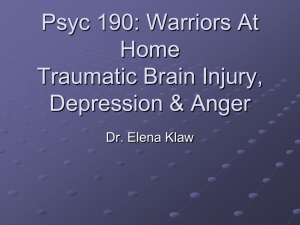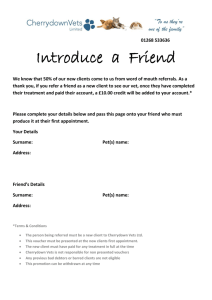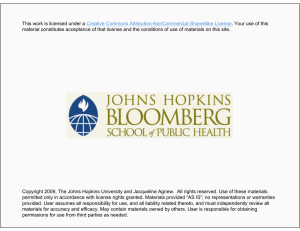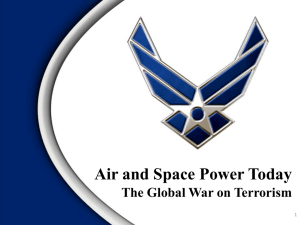Military Culture
advertisement
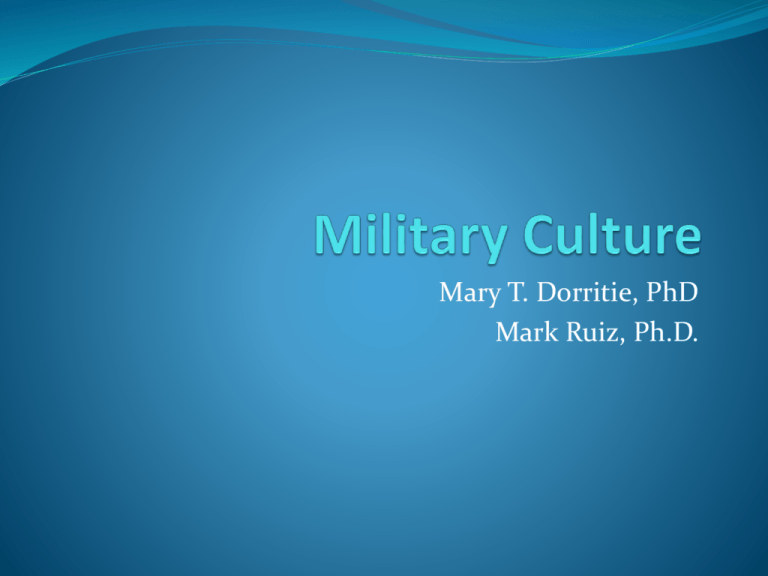
Mary T. Dorritie, PhD Mark Ruiz, Ph.D. Objectives Learn to obtain a client’s military service background Understand the goals of military medicine Understand the importance of rank and structure Understanding the “Us vs. them” mentality Identify important resources OIF/OND: Fatalities = 4,491; Wounded= 32,243 OEF: Fatalities = 2,345; Wounded= 19,996 A caveat… Although vets all share their service and certain experiences in common, there are distinct differences between the services. Today, you’ll be hearing things mostly from the Army perspective. Don’t be afraid to ask questions! Most Vets/Troops will appreciate your willingness to ask and NOT ASSUME. Afghanistan Parking Lot Military Structure Department of Defense (DOD) (CINC PRESIDENT) ARMY Reserve NAVY Reserve AIR FORCE Reserve National Guard National Guard (CINC Governor) (CINC Governor) MARINES Reserve COAST GUARD Reserve Rank & Structure It’s all about DISCIPLINE We know EXACTLY where and how we fit into the organizational structure Interchangeable parts Your uniform is your resume Normal tension between officers and enlisted Role of the officer vs. role of the NCO and other enlisted We call NCO’s the ‘backbone of the Army’ Many vets often choose post-military careers in law enforcement, corrections, firefighting, EMT, etc. Increased concerns about privacy due to employment. Reality of Security Clearance procedures “Us vs. Them” Team work and “Esprit de corps” Many vets, particularly combat vets, view themselves as different from civilians If you fail to acknowledge this or ‘brush it aside,’ vet will typically write you off Several reasons: Perceived lack of discipline in civilian society/workplaces Views on life and death, what’s important “Mission first” mindset Treatment many vets received from civilians upon redeployment Lack of knowledge/awareness in civilians “I didn’t realize we had people in Afghanistan.” “What is OIF?” Insensitive questions, un-invited political commentary “How many people did you kill.” “We should stop using drones, they are killing too many civilians.” Over concern from others Tactical awareness versus Hyper-vigilance; Lethally armed versus Locked and Loaded 1 year re-adjustment period for every year deployed (Walter Reed Army Institute of Research) Different (unofficial) norms for appropriate behavior within the military “Us vs. Them” cont. How do we deal with this when working with Veterans? Acknowledge it. If you’ve had a family member in the military, share that with the Vet. Don’t pretend to understand/know terminology, tactics, ‘what it was like.’ ASK if you don’t know what something means, Vets are usually glad to explain. The Military Family/Unit Cohesion Traditional nuclear structure, but with an increasing number of single parents, dual military couples, and couples in which the wife is the military member Military member typically works long hours- 8-hour days are almost unheard of Non-military spouse bears most of the childcare duties, attends school functions, often takes care of financial management (this is even more pronounced during deployments) Because of frequent PCS’ing, non-military spouse often can’t find a job at each new post Kids tend to be pretty resilient, used to moving and having to make new friends Active vs. Guard/Reserve Active- move around a lot, don’t get to stay with the same troops for more than 2-3 years, usually. Guard/Reserve- often serve with the same people for YEARS. They get to know each other’s families, kids go to school together, they may work in civilian jobs together, etc. OEF/OIF – Largest mobilization of Guard/Reserve since WWII. This is a primary reason that Active troops often view Guard/Reserve as having “slack” discipline. Variable discipline across units (line combat units vs. highly skilled medical units). Typically older than active component. Deployment differences- very different homecomings/readjustment periods. Increased rates of mental health problems between 3-12 months post deployment (Milliken et al., 2007). Military Medicine “Mission First” vs. Patient Centered Treatment Use of sick call Lack of autonomy/Institutionalized mindset Needs of the Army Soldier Readiness Program (SRP) Vaccinations Lack of Confidentiality Command’s “Need to Know” The role of the Chaplain. More accepted source of help. Military History What branch of service were you in? What was your time in service (TIS)? What was your MOS (the job you did)? Level of security clearance Confidential, Secret, Top Secret, TS-SCI Types of Discharge (Form DD214) Honorable General Other than honorable Dishonorable/Bad Conduct Character of discharge impacts access to benefits & services. Any Honorable discharge qualifies a veteran for many services. Military decorations (awards) Congressional Medal of Honor Purple Heart Valor Awards–Examples-Silver Star, Navy Cross. Military History cont. Deployments and Associated Health Concerns Combat WWII – Cold injuries, chemical warfare experiments, exposure to nuclear weapons, malnutrition and related ailments Korea- Cold injuries, diabetes, peripheral vascular disease, malnutrition and related ailments Vietnam- Agent Orange exposure-www.va.gov/agentorange, PTSD, Hepatitis C Desert Shield/Desert Storm (Saudi Arabia/Kuwait/Iraq)- Depleted Uranium, chemical and biological agent exposure, leishmaniasis OEF (Operating Enduring Freedom- Afghanistan) OIF (Operation Iraqi Freedom) OND (Operation New Dawn- as we were leaving Iraq) For all of these- PTSD, Traumatic Brain Injury (TBI), blast exposure, amputations, exposure to burn pits, orthopedic injuries from carrying heavy gear Peacekeeping- not a large body of research on health effects of these operations Bosnia/Kosovo Somalia Hurricane Katrina West Africa (fight against Ebola) Resources for Signature Conditions • VA Trauma Recovery Clinic • VA Post-Deployment Clinic • PTSD Residential Treatment (Bay Pines, Miami) • Vet Centers • VA Women’s Center • Trauma Recovery Clinic • Residential MST program (Bay Pines) Post Traumatic Stress Disorder (PTSD) Substance Abuse • ADATP program (Tampa) • SARRTP (Bay Pines, Miami, Gainesville, Orlando) Military Sexual Trauma (MST) Traumatic Brain Injury (TBI) • VA Polytrauma Treatment and Rehabilitation. • SCI Increased rates of mental health problems between 3-12 months after deployment (Milliken et al., 2007). Conclusion Military society is its own subculture. There are norms and mores that differ from those of civilian society, often leading military members and families to feel like they ‘don’t belong.’ Few people in our country have a direct connection to the military. Military is becoming increasingly diverse and offers opportunities to excel for anyone with the skills and drive necessary, regardless of race, gender, or ethnicity. Important resources: http://www.ebenefits.va.gov http://www.va.gov http://www.tampa.va.gov Further training http://www.deploymentpsych.org/military-culture This is a FREE online training developed jointly by VA and DoD. 4 modules, 2 CE’s each (again, FOR FREE!) Questions?
